Foundation Repair & Replacement
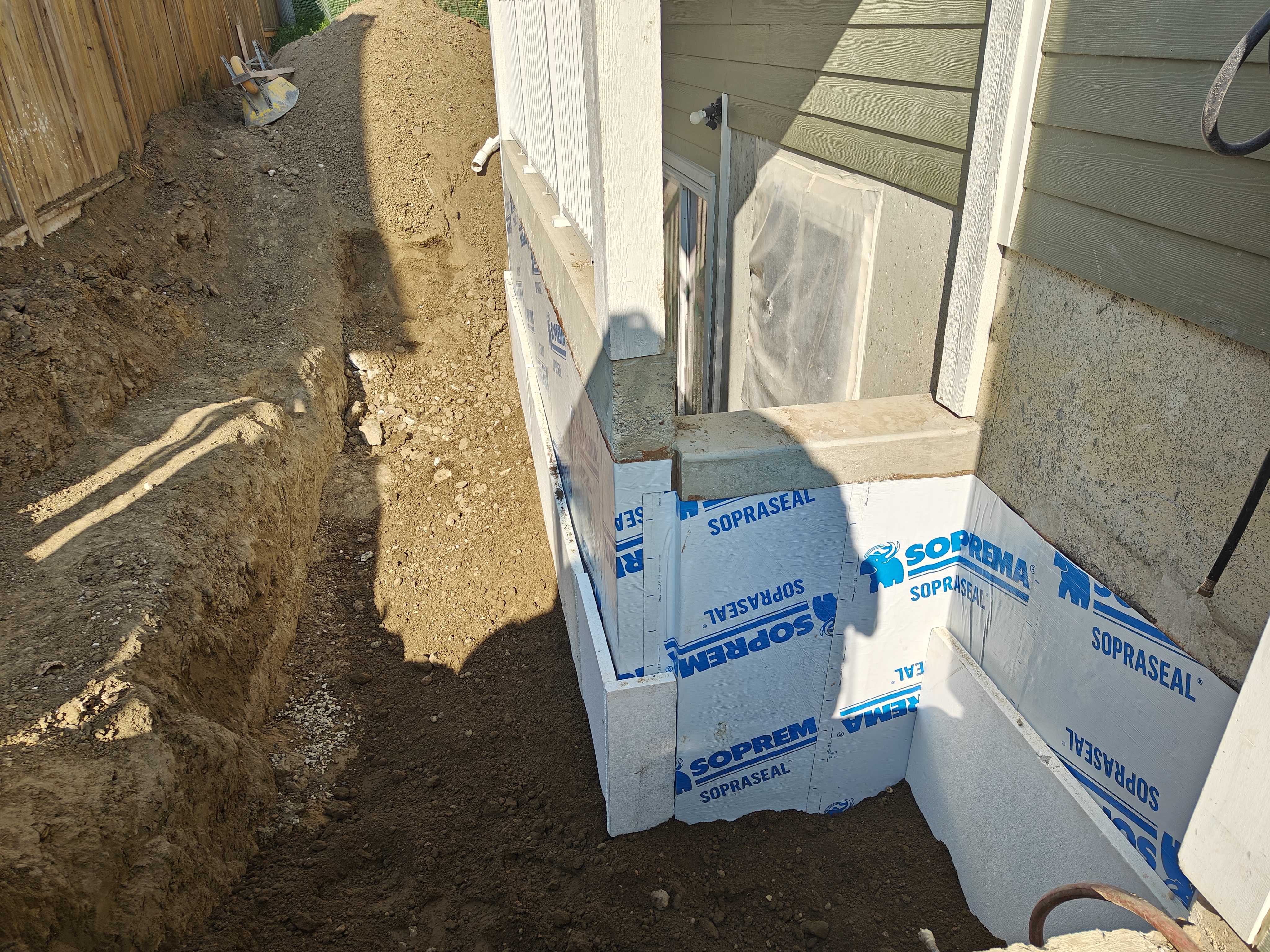
We offer structural concrete repair and modification. Most often we are asked to look at varying types of foundation damage and provide solutions for repair, but we also deal with remediation of structural slabs and other technical concrete. We offer foundation waterproofing in conjunction with our sister company DirtWright, and will also deal with wood foundations. As with other repair work, correct analysis of the failure modes is central to the success of the repair. In all cases, the repair options are more costly than the price of building well initially.
Structural Failure Modes
Here are some common structural concrete failures:
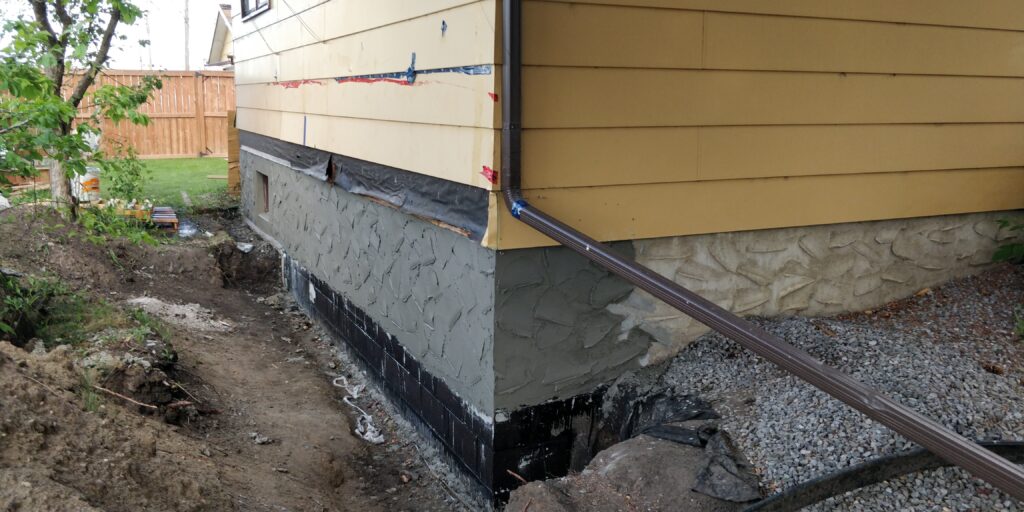
- Concrete Decay & crumbling. There are many root causes but the net effect is similar. CSA and ACI codes have more detailed information on these:
- Heat Damage. High heat can affect the chemical bonds of the concrete or heat up moisture in concrete and cause failure.
- Chemical exposure and attack. This can happen from incorrectly matching concrete class to use case, or from insufficient protection of the concrete from damaging chemicals.
- Sulfate attack. This can be from chemical exposure or from ground/water borne solutes. Curing history has an effect on concrete vulnerability to sulfate damage.
- Internal reactivity, which requires moisture to facilitate the reaction and generally show up slowly over time. AAR/ASR are examples of this.
- Frost Damage – incorrect concrete formulation to handle exposure to freeze/thaw cycling.
- Rebar Corrosion. This is usually related to moisture carrying ions into reinforcing steel and causing corrosion, which causes the steel to convert to higher volume rust. This expanded volume of rust exerts pressure on the concrete and eventually will cause the concrete to break apart. In this case the concrete matrix is still chemically sound, but the assembly experiences excessive stress from the rebar corrosion and fails. Rebar corrosion is also dangerous because the steel loses strength and the composite effect between concrete and steel is reduced.
- Physical / impact / wear damage. Vehicle impacts and repeated mechanical wear are examples of this.
- Poor concrete quality or placement, including poor hot/cold weather protection and thermal management/curing practices
- Overheating during curing. This can favour undesirable reaction products in the cement that impact concrete strength and durability.
- Overloading of the concrete structure. This can be from poor design and/or execution (skimping on concrete grade or reinforcing steel), or failure after a consistent weakening of the structure by other mechanisms mentioned above.
Foundation Repair
The repair options available vary with the failure mode. In all cases it is necessary to ensure that the repair will match the intended use and structure of the concrete – the repair should be structurally sound. This can involve engineering and testing to determine the damage extent and appropriate repair procedures. Usually these involve removing the damaged area, cleaning up the rebar, and tying back into existing sound concrete using a combination of epoxy, steel, concrete, and technical concrete patching materials. In cases of chemical attack or severe mismatch between exposure and concrete class it might be difficult to get to sound concrete or to ensure further failure, so full replacement may be a more feasible option. Reinforcing with steel, carbon fibre straps, or other systems may be used as well to ensure the structure can meet its duty.
Epoxy Foundation Repair
We are often asked about concrete foundation repair. These can range from a simple epoxy injection and waterproofing to full scale structural repair or rebuild. Cracks that are stable and not too wide can generally be repaired with an epoxy injection, though we usually recommend waterproofing the backside of the wall (dirt side) to guard against any leaks from foundation movement. The epoxy is rated as stronger than the concrete and has more flex than concrete, but all foundations can move a little bit, and the concrete can crack adjacent to the repair if sufficient movement is experienced unless additional structural reinforcing is installed. For this repair to be feasible without additional reinforcing the foundation should be stable and the crack should generally be narrow and vertical.
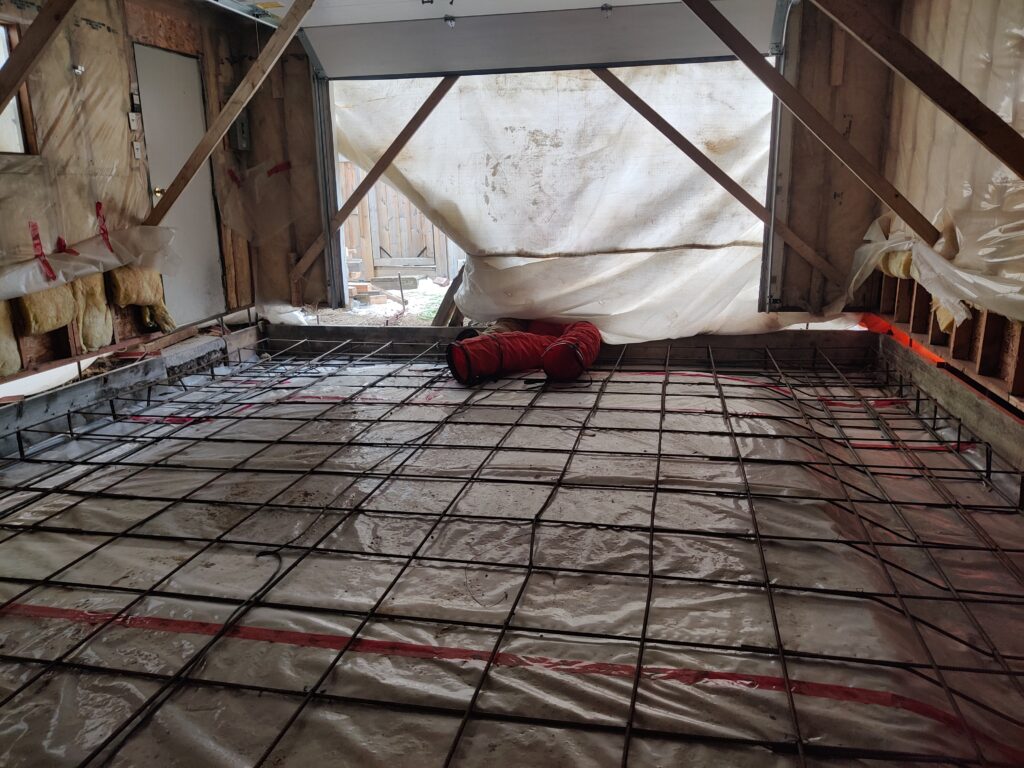
Structural Foundation Repair
Larger cracks in the concrete, horizontal cracks, and/or displacements out of plane usually point to a structural issue, such as unstable soil, weak foundation concrete structure, unexpected soil pressure or surcharge, and/or other problems. These need assessment by a professional to determine the best repair option. Cracking and deteriorating concrete that is otherwise stable may be remediated by engineering structural reinforcing (wood walls, metal, carbon fibre, or a combination) which may also include epoxy work to fill cracks and waterproofing. In some cases it will be a better value to temporarily carry the supported structure and rebuild the affected foundation section in place. This is a feasible option in the case of failing addition foundations or localised damage such as from vehicle impacts.
Underpinning and foundation replacement
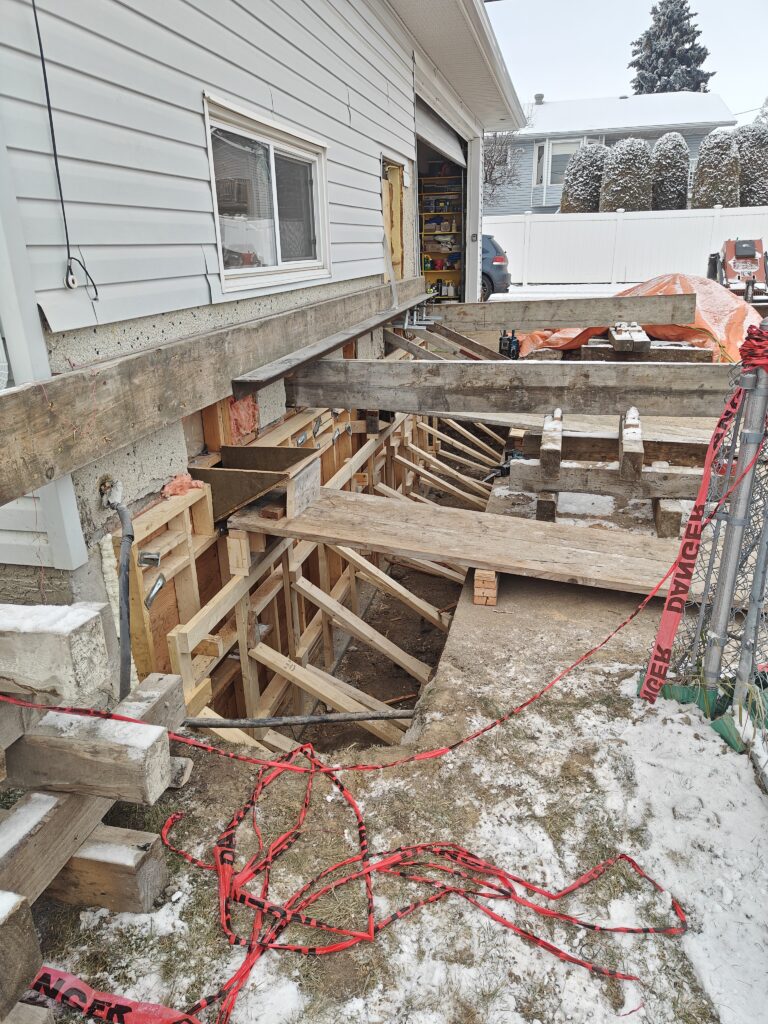
Unstable soil can cause foundation movement. Certain types of soil can swell depending on moisture content, and some soil is frost susceptible and will heave given the correct set of conditions. Building on organic material will cause structure movement, as will insufficiently compacted or weak material. Undersized piles or footings can also cause foundation failure. If your structure is failing from geotechnical issues like these it may be necessary to involve an engineer. Solutions can involve foundation underpinning with piles or correctly sized footings to properly transfer the foundation load to the soil, or removing deleterious fill and appropriately correcting the foundation. In some extreme cases, full foundation replacement can be necessary to establish sufficient bearing structure for the foundation.
Foundation Waterproofing Repair
Foundation repair and waterproofing are closely related- usually a foundation repair call will involve some form of waterproofing. Wet foundations spaces are not very useful. In some cases, the water can be primary to the failure, as in the case of degrading concrete from waterborne solutes, but often the water leakage is only a symptom of a foundation problem. The root cause should be dealt with first – then waterproofing can be carried out without fear of further failure. Often the foundation repair and waterproofing can be done in the same operation, which is most efficient. In many cases correct site grading and site drainage can mitigate problems from foundation water. Keeping the water away from the foundation like this is the first defense against a leaky foundation.
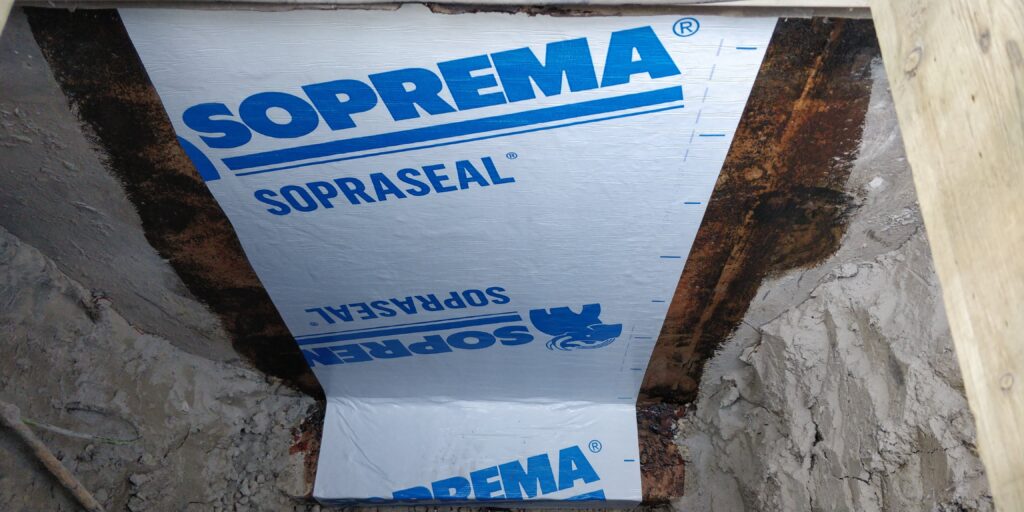
It is important that foundation waterproofing repair is done correctly. This is best done from the exterior with self-sealing membranes, which will involve excavation and cleaning of the foundation. Sealing from the exterior keeps the concrete dry and limits further waterborne damage, if it is occurring. Using premade membranes allows consistent, reliable coverage and takes advantage of materials engineering advances that are more reliably executed in a factory. Tar is a good standby and has its use case, but it can wear off over time and coverage depends on the applicator. Newer two component systems can offer high performance, but rely on correct substrate preparation, correct mixing, correct application, and the correct site conditions to reach these performance standards.
Interior waterproofing is cheaper, but can be difficult to execute well, and does not protect the concrete. We see contractors offering coatings for the interior concrete wall with compounds (glue) as waterproofing solutions. These can limit moisture ingress for awhile, but will not prevent water from going into the concrete. The foundation can continue to deteriorate if the concrete is being exposed to freeze-thaw damage or chemical attack (sulphate attack) through the soil moisture. This may be an option if the expected lifespan of the structure is too short to justify the cost of doing the job correctly, but we generally don’t recommend it. Best waterproofing performance and durability come from a well done exterior waterproofing solution with a secondary drainage system such as dimple wrap to evacuate water from the foundation plane. This is then drained away with weeping tile.
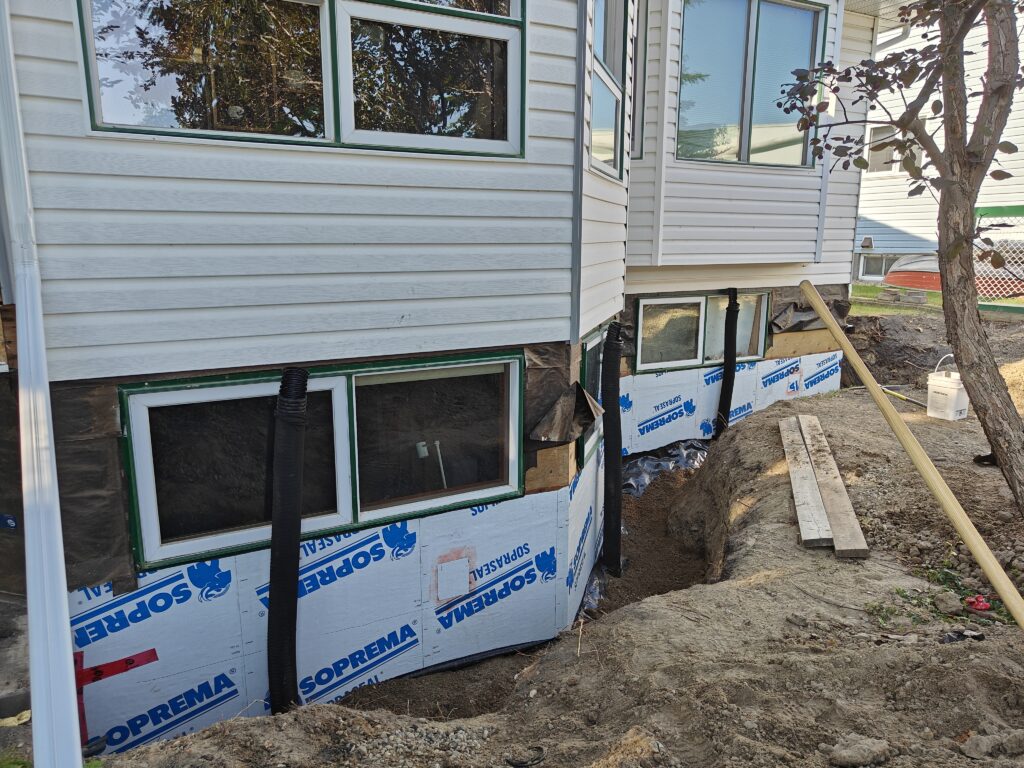
Weeping Tile & Foundation Drainage
Waterproofing the foundation will deal with overland water, but does not deal with groundwater. This is the job of the weeping tile system. Most newer houses will have this. It is a perforated pile run around the footing of the building and covered with washed gravel and (ideally, but not commonly) filter fabric; this typically drains to a sump which is then pumped out. It’s the backstop of the foundation waterproofing and prevents any foundation leaks from getting out of hand. If your building is older and missing the weeping tile or it has filled up with sediment and is no longer functioning (perhaps because the filter fabric was skipped), it will be necessary to install a new system. This can be done from the interior by cutting the floor and putting a weeping tile system below the slab, adjacent to the footing. An interior weeping tile install is usually cheaper than the alternative of a weeping tile system at the exterior, save for cases where the exterior of the foundation is more accessible or is already being excavated to repair waterproofing.
There are always solutions for structural concrete repair and foundation waterproofing, but they are not cheap. As with all construction, it is better to build well the first time. The cost of a structural foundation repair is typically 10-100 times the cost of what it would have taken to prevent the failure. If you’ve found yourself with concrete in need of repair or replacement, give us a call or fill out this contact form. We’ll be able to offer some options.

